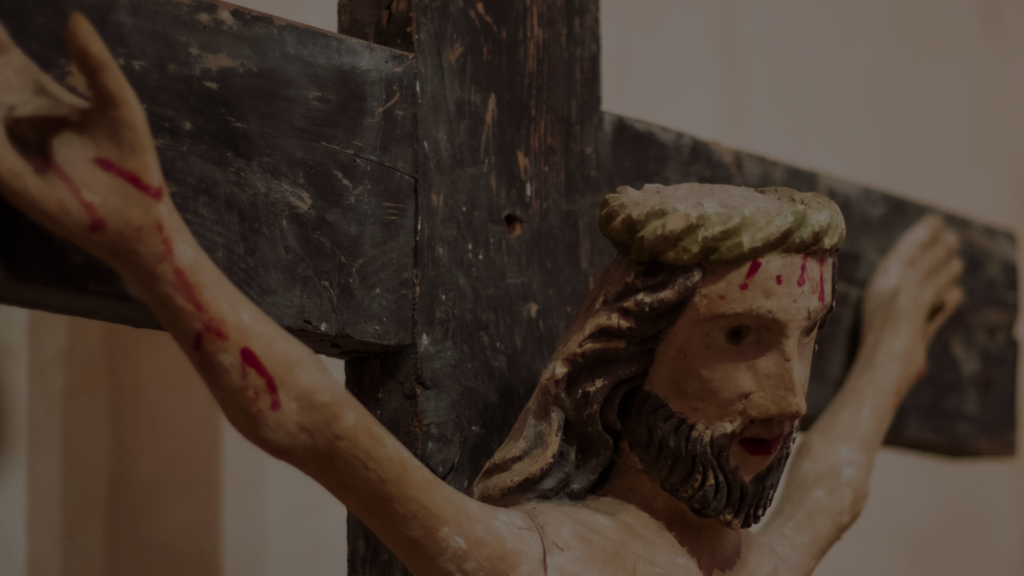Today, Good Friday, we commemorate the crucifixion of our Lord Jesus Christ. This is the day in which we fix our gaze on the cross and meditate on what we are worth to God. In the excerpt below, St. John Chrysostom draws us to meditate on the immense power of our Lord’s blood.
Below is the second reading from the Office of Readings for Good Friday:
If we wish to understand the power of Christ’s blood, we should go back to the ancient account of its prefiguration in Egypt. Sacrifice a lamb without blemish, commanded Moses, and sprinkle its blood on your doors. If we were to ask him what he meant, and how the blood of an irrational beast could possibly save men endowed with reason, his answer would be that the saving power lies not in the blood itself, but in the fact that it is a sign of the Lord’s blood. In those days, when the destroying angel saw the blood on the doors he did not dare to enter, so how much less will the devil approach now when he sees, not that figurative blood on the doors, but the true blood on the lips of believers, the doors of the temple of Christ.
If you desire further proof of the power of this blood, remember where it came from, how it ran down from the cross, flowing from the Master’s side. The gospel records that when Christ was dead, but still hung on the cross, a soldier came and pierced his side with a lance and immediately there poured out water and blood. Now the water was a symbol of baptism and the blood, of the holy eucharist. The soldier pierced the Lord’s side, he breached the wall of the sacred temple, and I have found the treasure and made it my own. So also with the lamb: the Jews sacrificed the victim and I have been saved by it.
There flowed from his side water and blood.Beloved, do not pass over this mystery without thought; it has yet another hidden meaning, which I will explain to you. I said that water and blood symbolized baptism and the holy eucharist. From these two sacraments the Church is born: from baptism, the cleansing water that gives rebirth and renewal through the Holy Spirit, and from the holy eucharist. Since the symbols of baptism and the eucharist flowed from his side, it was from his side that Christ fashioned the Church, as he had fashioned Eve from the side of Adam. Moses gives a hint of this when he tells the story of the first man and makes him exclaim: Bone from my bones and flesh from my flesh! As God then took a rib from Adam’s side to fashion a woman, so Christ has given us blood and water from his side to fashion the Church. God took the rib when Adam was in a deep sleep, and in the same way Christ gave us the blood and the water after his own death.
Do you understand, then, how Christ has united his bride to himself and what food he gives us all to eat? By one and the same food we are both brought into being and nourished. As a woman nourishes her child with her own blood and milk, so does Christ unceasingly nourish with his own blood those to whom he himself has given life.
Reflection:
“By one and the same food we are both brought into being and nourished.”
How beautiful.
This is the great gift we receive from the outpouring of our Lord’s blood. It is in his very act of self-gift that we, the Church, come into being. The blood, symbolizing his life, pouring out from his side is the seed of our supernatural life.
Every time we approach our Lord in the Holy Eucharist we are receiving this same gift of divine life. Therefore, as members of Christ’s Body we are both sustained and nourished in this perpetual self-offering of the Lord.
How will you approach the altar and table of the Lord this weekend? Will you, in response, give your heart and life to the Lord?
What insight has the Holy Spirit given to your from your reading of St. John Chrysostom’s words?
Let me know below in the comment box!

Are you often asked what the Catholic Church teaches about tough subjects? Are you curious about what the Church teaches?
In this Tough Catholic Teachings cheat sheet I provide for you direct links to the paragraphs in the Catechism of the Catholic Church that speak specifically about these tough topics.
You won’t need to go searching for what the Catholic Church actually teaches about these subjects as you will have direct access to the Catechism’s teaching all in one place!

